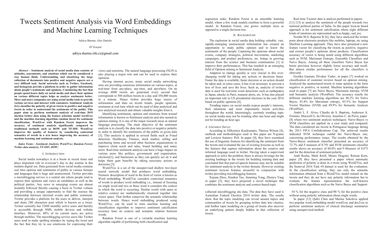Tweets Sentiment Analysis via Word Embeddings and Machine Learning Techniques
Sentiment analysis of social media data consists of attitudes, assessments, and emotions which can be considered a way human think. Understanding and classifying the large collection of documents into positive and negative aspects are a very difficult task. Social networks such as Twitter, Facebook, and Instagram provide a platform in order to gather information about peoples sentiments and opinions. Considering the fact that people spend hours daily on social media and share their opinion on various different topics helps us analyze sentiments better. More and more companies are using social media tools to provide various services and interact with customers. Sentiment Analysis (SA) classifies the polarity of given tweets to positive and negative tweets in order to understand the sentiments of the public. This paper aims to perform sentiment analysis of real-time 2019 election twitter data using the feature selection model word2vec and the machine learning algorithm random forest for sentiment classification. Word2vec with Random Forest improves the accuracy of sentiment analysis significantly compared to traditional methods such as BOW and TF-IDF. Word2vec improves the quality of features by considering contextual semantics of words in a text hence improving the accuracy of machine learning and sentiment analysis.
PDF Abstract


